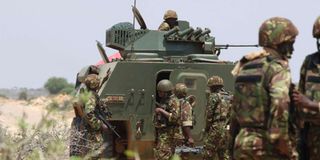Breaking News: At least 10 feared to have drowned in Makueni river
Let Ruto boost Kenya-Somalia bilateral ties

Kenya Defence Forces soldiers under Africa Union Mission in Somalia (Amisom) patrol Kismayo town on November 22, 2015. The presence of Kenyan troops in Somalia requires the goodwill of the Somali people to effectively execute their mandate.
What you need to know:
- The two neighbours now have another opportunity to improve bilateral ties for the benefit of their citizens and the region.
- Kenya’s peace and security are largely dependent on the political stability of the Horn of Africa country.
- The presence of Kenyan troops in Somalia requires the goodwill of the Somali people to effectively execute their mandate.
No doubt, retired President Uhuru Kenyatta’s tenure, and that of his Somalia counterpart, retired President Mohamed Abdullahi Farmaajo, saw the Kenya-Somalia bilateral relations plunge to the bottom.
The frosty relationship between the two immediate presidents of the neighbouring countries culminated in a maritime border dispute that was adjudicated at the International Court of Justice (ICJ) and whose ruling on October 12, 2021, Kenya rejected.
At some point, envoys from both sides were sent to the metropole for consultation and the matter was threatening to turn into a military clash that would have destabilised entire eastern Africa.
On May 23 this year, President Hassan Sheikh Mohamud was elected president for the second time.
During his earlier tenure in 2012-2017, Nairobi and Mogadishu had relatively warm relations, though the border case was instituted then, in 2014.
And now, with the recent election of President William Ruto as Kenya’s fifth President, the two neighbours have another opportunity to improve bilateral ties for the benefit of their citizens and the region.
And there are many strategic reasons why Kenya and Somalia have no choice but to work together.
Horn of Africa stability
First, Kenya’s peace and security are largely dependent on the political stability of the Horn of Africa country.
Kenya shares a 700-kilometre land boundary with Somalia which is largely porous. Transnational crimes across this border can only be tamed if the two countries cooperate.
Secondly, Kenya’s military is in Somalia until December 31, 2024, under the African Union Transitional Mission in Somalia (ATMIS), which replaced the AU Mission in Somalia (Amisom) that had, for 15 years, tried to stabilise the war-torn country.
The armies of Kenya and other countries, therefore, play a critical role in preparing Somalia’s security agencies to take charge of their country’s security.
Consequently, the presence of Kenyan troops in Somalia requires the goodwill of the Somali people to effectively execute their mandate.
Thirdly, even with more than two years of ATMIS’s mandate remaining, Somalia and Kenya will still have to work together in other areas, such as trade. In preparation for that, they should be exploring areas to deepen cooperation.
Indeed, Somalia should consider joining the East African Community (EAC) and integrating more with its members as it prepares to consolidate peace and integration in the region.
After all, isn’t Somalia geographically not more easterly than any of the current EAC members?
And with Central Africa’s Democratic Republic of Congo (DRC) already a member of the EAC, what prevents Somalia from joining the regional bloc?
Lastly, while the ICJ ruling on the maritime border dispute is final, its implementation or otherwise is largely dependent on the mutual agreement between the two countries.
Options include utilising other regional mechanisms within the AU and others below it, such as Intergovernmental Authority on Development (Igad).
Dr Kirui (PhD) is head of Humanities Department and lecturer of history and government at the University of Eldoret. [email protected].





